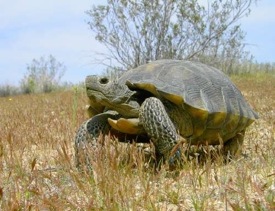It had been a good month for BrightSource Energy, the Oakland-based company that’s building the massive Ivanpah solar farm in the Mojave Desert.
Google announced it would invest $168 million in the project. The Department of Energy announced $1.6 billion loan guarantee. And on Friday, the company announced it plans to go public with a $250 million initial public offering. But a recurring issue has popped up: the desert tortoise.

“It’s an endangered species. No project that is sited out there in within their habitat can negatively impact the population,” says Erin Curtis, a spokesperson for the Bureau of Land Management. As anyone following the battles over solar farms knows, prime desert tortoise habitat also happens to be prime solar territory and has been targeted by a number of proposed solar farms.
BrightSource Energy agreed to mitigate the impacts their solar farm would have on the tortoises by capturing and relocating them to new habitat. Fences are being constructed to prevent the tortoises from returning.
In all, biologists are allowed to relocate or handle 38 tortoises over the lifetime of the project. But they’ve been finding more tortoises than expected and have already hit that limit.
“Therefore we needed to suspend activities so we didn’t touch another tortoise until we have a new biological opinion. You’re trying to manage wild animals and they don’t act in a predictable fashion. It’s adaptive management and we learn new things all the time,” says Curtis.
BLM has shut down construction on two sections of the solar thermal farm, until the Fish and Wildlife Service can issue a new decision on how many tortoises are in the area and where they could be relocated to. Biologists are now estimating that roughly 140 tortoises could live in the 3,500 acre project footprint.
That decision is expected to take three to four months and surveys are currently underway. BrightSource Energy has said they don’t expect the solar farm to be delayed.
